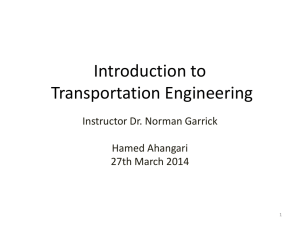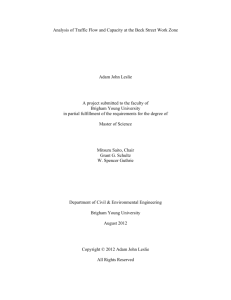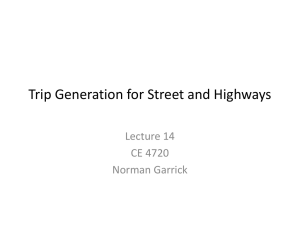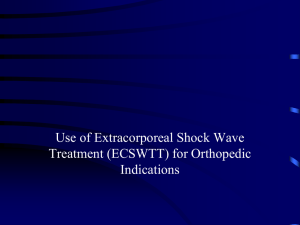CE 2710 Lecture 14 Traffic Time Distance Diagram and Shock Flow
advertisement
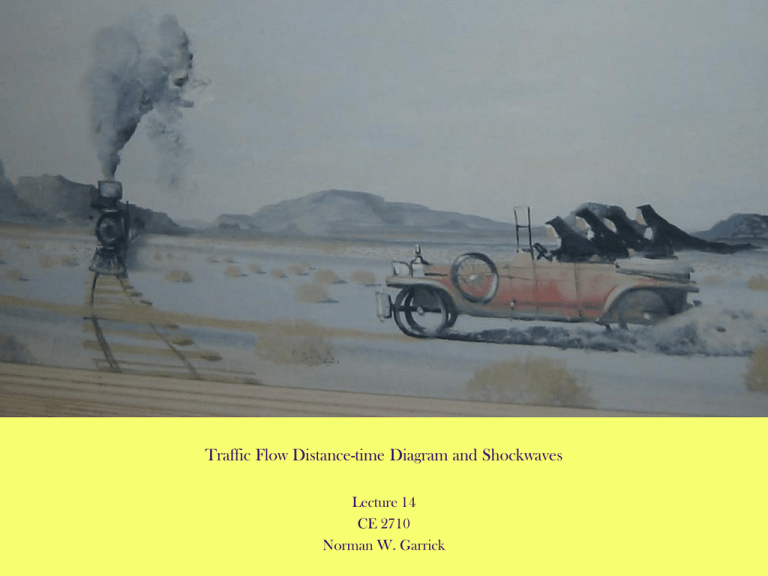
Traffic Flow Distance-time Diagram and Shockwaves Lecture 14 CE 2710 Norman W. Garrick Time-Distance Diagrams of Traffic Flow Vehicle 1 u1 = 50 mph (constant) Vehicle 2 u2 = 30 mph (constant) Distance Slope = speed s h Fix Position Time Fix Point in Time Norman W. Garrick Time-Distance Diagrams of Traffic Flow Distance Time Norman W. Garrick Time-Distance Diagrams Actual Traffic Flow Ref: Papacostas and Prevedouros Norman W. Garrick Shock Waves A shock wave occur when there is a change in the travel condition on the roadway that affect the stream flow. For example, a shock wave occur when drivers slow down to look at an accident (rubberneck) - this can cause a traffic jam that is seemingly more dramatic than one would expect given the nature of the act that caused it. Shock waves can be associated with a particular vehicle in the stream slowing down or stopping A shock wave is also associated with the traffic pressure being released and a traffic jam dissipating Norman W. Garrick Example of a Shock Wave At a Stop T = t1 sec Traffic is flowing normal Flow, q = 500 veh/hr Conc, k = 10 veh/mi Norman W. Garrick Example of a Shock Wave At a Stop T = t2 sec Flagman stops first vehicle in the queue Shockwave Norman W. Garrick Example of a Shock Wave At a Stop T = t3 sec More vehicles have joined the queue The shockwave have moved backwards Shockwave 1 State 1 q = 500 veh/hr k = 10 veh/mi State 2 q = 0 veh/hr k = 260 veh/mi On either side of the shockwave there are two different state of flow Norman W. Garrick Example of a Shock Wave At a Stop T = t4 sec Flagman releases queue Shockwave 1 State 1 q = 500 veh/hr k = 10 veh/mi Shockwave 2 State 2 q = 0 veh/hr k = 260 veh/mi State 3 q = 1000 veh/hr k = 110 veh/mi There is now a second shockwave and a third state of flow the flow state for traffic released from the queue Norman W. Garrick Distance-Time Diagram for Shock Wave Distance X Shockwave 1 Shockwave 2 Time Norman W. Garrick Calculation of Shockwave Travel usw = (q2-q1) / (k2-k1) Shockwave 1 State 1 q = 500 veh/hr k = 10 veh/mi State 2 q = 0 veh/hr k = 260 veh/mi The speed of the shockwave can be calculated using the above equation The sign is important so remember to number the travel states from upstream to downstream If the sign is +ve it means that the shockwave is moving downstream Norman W. Garrick Calculation of Shockwave Travel Shockwave 1 State 1 q = 500 veh/hr k = 10 veh/mi State 2 q = 0 veh/hr k = 260 veh/mi Speed of Shockwave usw1 = (q2-q1) / (k2-k1) (0-500) / (260-10) = - 2 mph Shockwave 1 is moving upstream at 2 mph What is the length of the queue after 3 minutes Length = u*t = 2 mph * 3/60 hr = 0.1 mile How many vehicles are in the queue after 3 minutes no. of vehicles = k * L = 260 *0.1 = 26 vehicles Norman W. Garrick Calculation of Shockwave Travel Shockwave 1 State 1 q = 500 veh/hr k = 10 veh/mi Shockwave 2 State 2 q = 0 veh/hr k = 260 veh/mi State 3 q = 1000 veh/hr k = 110 veh/mi Speed of shockwave 2 usw2 = (q3-q2) / (k3-k2) (1000-0) / (110-260) = - 6.67 mph Shockwave 2 is moving upstream at 6.67 mph Norman W. Garrick Calculation of Shockwave Travel Shockwave 1 State 1 q = 500 veh/hr k = 10 veh/mi Shockwave 2 State 2 q = 0 veh/hr k = 260 veh/mi State 3 q = 1000 veh/hr k = 110 veh/mi How long will it take to clear the queue if the flagman held the queue for 3 minutes Length after 3 minutes = u*t = 2 mph * 3/60 hr = 0.1 mile usw1 = - 2 mph usw2 = - 6.67 mph Therefore the queue will dissipate at rate of 4.67 mph Time to dissipate a 0.1 mile queue is L/speed 0.1 mile / 4.67 mph = 0.021 hr = 12.6 minutes Norman W. Garrick

